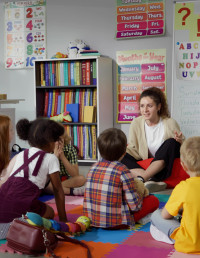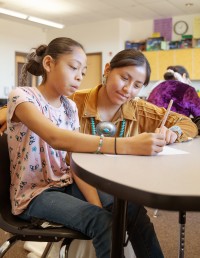Elevating Equity During the Pandemic: CA School District Distance Learning Plans That Support the Needs of Vulnerable Students

"I serve in the community I grew up in. Several families face equity concerns daily; adverse childhood experiences, trauma, food scarcity, lack of work or housing, and other concerns that interrupt a child's learning. For my students, all of these concerns are heightened - worsened - under this global pandemic. We should continue to lean on one another and to encourage innovation and creativity and recognize students as thought-partners in this work." – Estella Owoimaha-Church, Secondary English/Theatre Teacher and member of Leading Educator Ambassadors for Equity (LEAE) of the Education Civil Rights Alliance.
>>>NEW REPORT How Districts Planned for Pandemic Learning: Equity-Driven Practices and Lessons Learned from 2020 Learning Continuity and Attendance Plans
School districts must maintain an eye toward equity for all students during the COVID-19 pandemic. We hope that families, advocates and school districts in California can find guidance on this page on how to creatively address selected education equity concerns during the pandemic.
Fall 2020 Recommendations for Learning Continuity and Attendance Plans
School districts in California must complete Learning Continuity and Attendance Plans (LCPs) by September 30, 2020. LCPs are tools for transparency and accountability, in which districts describe how they will use state and federal funds during the 2020-21 school year to support students, particularly students who are English Learners, foster youth, youth in the juvenile justice system, and youth experiencing homelessness ("students with unique needs").
NCYL collaborated with advocacy partners to develop specific recommendations for actions school districts should implement during the school year to support students with unique needs. We partnered with the California Department of Education to present these recommendations during a webinar on August 27, 2020. Click here for the webinar slides, recording and full list of LCP recommendations.
Spring 2020 Recommendations for Distance Learning
In Spring 2020, NCYL and a coalition of education advocates developed eight recommendations to promote student equity during and in the immediate aftermath of the pandemic. Click here for more details regarding those recommendations.
Below, we linked examples of school districts whose publicly stated policies were aligned with our recommendations. While implementation of these policies was a work in progress, it was promising that districts were making commitments to these practices at the time.
This research was compiled by the Education Advocacy Clinic at East Bay Community Law Center, a clinic of Berkeley Law School; Law Foundation of Silicon Valley, Legal Advocates for Children and Youth; and National Center for Youth Law.
This webpage was last updated on August 28, 2020.
1. Make District COVID-19 Learning Plans Transparent and Accessible for all Families. This includes posting printable documents on district and County Office of Education websites, making documents available in multiple languages, and providing or facilitating access to technology. See related district plans in:
-
- Acalenes Union High School District, Dublin, Piedmont, Pleasanton (distributed wifi hotspots and laptops/Chromebooks);
- Redlands Unified (website in English and Spanish; printable enrichment resource plans),
- San Francisco Unified (provides standalone distance learning guide for staff that is also accessible to families);
- Los Angeles Unified (provides standalone distance learning guide for families that includes COVID-19 district hotline number for all questions in English or Spanish);
- Monterey Peninsula Unified (using school buses to bring wi-fi routers to public areas);
- Mountainview-Whisman (providing wi-fi in their school parking lots)
- Piedmont Unified (publicizing a “plan for instructional continuity”, including expectations of teachers and ways to maintain human connection)
- Alameda County Office of Education (displaying distance learning plans for all districts in county on webpage)
2. Provide Enrollment/Reentry Opportunities for Vulnerable Youth. This includes ensuring youth reentering the community are promptly enrolled, complying with enrollment provisions for youth in foster care, youth in the juvenile justice system, and youth who are homeless, and ensuring continuity of services when students transfer. See related district plan in:
-
- San Ramon Valley Unified (enrollment for current school year will re-open on April 13, using online-only system)
3. Adjust School Discipline Policies to Better Support Students. This includes dismissing pending expulsion recommendations, rescinding expulsions subject to an appeal, readmitted students who are eligible to return to school during school closures, and prohibiting the use of suspensions.
-
- Berkeley Unified (reporting it is not conducting expulsion hearings during school closures)
- No related districts plans identified yet. Click here for a recent letter to the Governor recommending a moratorium on school discipline for suggested policies.
4. Ensure Students with Disabilities Receive Needed Services. This includes continuing to provide special education services, creating individualized distance learning plans aligned with students' special education programs, holding Individualized Education Program (IEP) meetings or postponing only if there is mutual agreement, and convening IEP meetings within 30 days of schools reopening. See related districts plan in:
-
- Antioch Unified (some students with disabilities - those in special day classes - will be contacted individually to discuss technology needs);
- Berkeley Unified (Special Education teachers will provide supplemental support, as described in each IEP, and will amend IEP documents when possible to reflect current conditions);
- Liberty Union High School District (psychological and speech services in IEPs will be provided remotely, and assignments will be modified by special education teachers);
- Redlands Unified (printable tip sheets on how to accommodate students with disabilities needing mild to moderate accommodations);
- San Jose Unified (special education teachers will reach out to every student to discuss plans);
- San Mateo Union High School District (IEP meetings held over video conference if parent consent, and another IEP meeting will be scheduled when schools reopen);
- Sequoia Union High School District (developed alternative plan for distance learning for students with IEPs)
- San Lorenzo Unified (development of individual emergency service plans for students with disabilities)
5. Provide Students in Alternative Schools with Access to Education Resources. This includes implementing technology-based distance learning strategies, continuing work with postsecondary partners, and communicating with students' families about their learning plans. Youth should be released from incarceration, but if they remain, County Offices of Education should coordinate with Probation to ensure students' mental and physical health is safeguarded while also prioritizing meaningful distance learning opportunities and connections to the community. See related district plans in:
-
- Monterey-Peninsula Unified (providing laptops to alternative school students);
- San Francisco Unified (specific information on distance learning standards for alternative education students, including individual check ins and proactive provision of technology to students)
6. Support Foster Youth with Access to Connection and Instruction. This includes increasing outreach by districts to foster youth and ensuring school stability rights are protected. See related district plans in:
-
- Los Angeles County Office of Education (created resource guide for foster youth and their support teams);
- Santa Clara County Office of Education (providing District Liaisons guidance on how to communicate with foster youth during pandemic);
- San Francisco Unified (reminds staff of right to school of origin in distance learning guide, and prioritizes wifi hotspots for youth in foster care, among other vulnerable youth)
7. Take a Supportive Approach Toward Attendance and Truancy. This includes eliminating referrals to the District Attorney's office due to truancy and eliminating formal or informal transfers of students to other schools.
-
- No related district plans identified yet
8. Encourage Compassionate Grading Practices. This includes ensuring no student's grade is negatively impacted during school closures, but that students have opportunities to improve their prior grades during the pandemic. See related district plans in:
-
- West Contra Costa Unified (work completed during school closure will not factor into grades, but students can make up prior work and improve grades);
- Antioch Unified (pass/no mark grades for high school);
- San Ramon Unified (pass/no mark for middle and high);
- East Side Union High School District (work completed during school closure will not factor into grades, but students can make up prior work and improve grades);
- Alameda Unified (tentative credit/no credit policy for middle/high with individualized feedback);
- Berkeley Unified (work during closure not graded; work assigned prior to closure can be completed for grade)
- Fremont Unified (grading for second semester was moved to credit/no credit)
District plans are changing rapidly as districts are able to complete planning and decide upon courses of action. We will add additional examples to this webpage weekly until the end of May 2020, when the school year ends for many districts. To contribute ideas to or ask questions regarding this webpage, please contact us.





